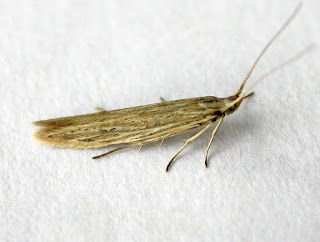Another couple of weeks have gone by, this time with wildly fluctuating totals ranging from 145 moths of 46 species on the 12th down to 10 moths of 8 species on the 16th (not helped by a power cut locally for a few hours after dark!) and then back up again. At the end of this period the nightly species count had returned to around 40 and overall moth numbers are now well above 200 with the charge being lead by Large Yellow Underwing (30+ per night but occasionally 60 or more of them), Square-spot Rustic (40+ per night) and Lunar Underwing (already 50+ per night within less than a week of its first appearance). New arrivals for the year-list have also continued to trickle in:
(8th) - nil -
(9th) - nil -
(10th) - nil -
(11th) - nil -
(12th) Ancylosis oblitella, Pink-barred Sallow, Deep-brown Dart.
(13th) Brown-spot Pinion.
(14th) - nil -
(15th) Lunar Underwing.
(16th) Beaded Chestnut.
(17th) Pine Carpet.
(18th) Yellow-line Quaker, L-album Wainscot.
(19th) Green-brindled Crescent.
(20th) Elachista freyerella, Dusky-lemon Sallow, Brick.
(21st) - nil -
 |
| Ancylosis oblitella, Westcott 12th September |
 |
| Pine Carpet, Westcott 17th September |
 |
| L-album Wainscot, Westcott 18th September |
The pyralid Ancylosis oblitella (12th) is resident in parts of the far south of England but seems to have occasional break-outs, perhaps backed up by immigration. Around the time my specimen appeared, which was the first to be seen here since 2018, there were quite a few records of it elsewhere beyond its normal range and they included places further north than Bucks. The rather tired-looking L-album Wainscot (18th) was a welcome first-time visitor to the garden of a spreading species which again could be backed up by migration. Otherwise, immigrants over this period were limited to Vestal (two on the 11th, another on the 12th) and continued occasional appearances by Udea ferrugalis/Rusty Dot Pearl and Nomophila noctuella/Rush Veneer. A single example of Plutella xylostella/Diamond-back Moth did turn up on the 20th but this often common species has been noteworthy by its absence for much of this year.
 |
| Lilac Beauty, Westcott 20th September |
Light Emerald, Beautiful Hook-tip and Straw Dot have started to re-appear again, while sightings here of less often recorded second brood individuals have included Riband Wave (21st), Lilac Beauty (20th) and Bright-line Brown-eye (18th).
On 11th September I had a Coleophora species to light which is unusually late to be seeing any example from that family, especially one as fresh-looking as this example was. It has been retained so that its identity can be properly established. After a flurry of thirteen examples in the garden between 18th July and 14th August, Webb's Wainscot appeared again on 18th September which is the latest date I've ever seen it, although the books do say that it can go on into October. Formerly regarded as a migrant, Dewick's Plusia turned up again on 12th September, this species having already put in three garden appearances during July. While some may still have been wanderers, it is likely that the moth is now a local resident too because there have been so many records of it in the last few years from across our area.
 |
| Coleophora species, Westcott 11th September |
As far as further macro-moths for the 2022 year-list are concerned, all I've got to look forward to between now and (hopefully) the end of this month are Mallow, Clifden Nonpareil, Large Wainscot, Blair's Shoulder-knot & Brindled Green, plus maybe Buttoned Snout & Large Ranunculus if I'm very lucky. October should bring the November Moths (including the likelihood of Autumnal Moth if I can be bothered to check lots of them), Feathered Thorn, Figure of Eight, Sprawler & Merveille du Jour, while November is sure to add December Moth & Scarce Umber to finish off the year's arrivals. Anything else will be a bonus! Already accounted for because they appeared on the list at the beginning of this year are the other common autumnal species such as Winter Moth and Mottled Umber, as well as Red-green Carpet (seen 8th September), Grey Shoulder-knot, Satellite (seen 21st September) and the Pinions and Chestnuts which hibernate during the coldest months.
2022 has been exceptional for migrant moths already but we haven't yet got to October which is often the best month for them, so there's still a chance that something exotic might turn up. The important thing is to keep on trying - don't put those moth traps away yet! Don't just rely on the traps either - ivy is now in blossom and if you have some near you then a torch-light search during the early part of the night can produce many moth records. October is also peak "leaf-mining" season. I know that's rather a niche interest for many people and it may not be quite as good this year because the hot weather has caused many trees to lose a percentage of their leaves already, but looking for leaf-mines is a good way of finding those tiny species which are difficult (or sometimes impossible) to identify as adults.
Dave Wilton Westcott, Bucks


No comments:
Post a Comment
Note: only a member of this blog may post a comment.